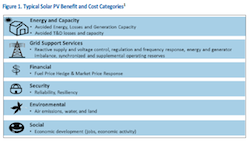 The U.S. Environmental Protection Agency (EPA) has announced its annual Green Power Leadership Awards, recognizing 19 Green Power Partners and four suppliers across the country—including the cities of Philadelphia and Las Vegas, Apple, Kohl’s, and Trek Bicycle Corporation–for achievements in advancing the nation’s renewable energy market and reducing greenhouse gas emissions fueling climate change.
The U.S. Environmental Protection Agency (EPA) has announced its annual Green Power Leadership Awards, recognizing 19 Green Power Partners and four suppliers across the country—including the cities of Philadelphia and Las Vegas, Apple, Kohl’s, and Trek Bicycle Corporation–for achievements in advancing the nation’s renewable energy market and reducing greenhouse gas emissions fueling climate change.- TheSierra Club is joining Ford Motor Company and SunPower’s Drive Green for Life program to help more Americans move toward emissions-free driving. Drive Green for Life offers Ford customers who own electric plug-in vehicles, including Focus Electric, C-MAX Energi Plug-In Hybrid and Fusion Energi Plug-In Hybrid, a $750 rebate on a SunPower residential solar system to generate clean, solar energy for the home and for electric vehicle charging. Also eligible are the C-MAX Hybrid and Fusion Hybrid. As Drive Green for Life’s newest partner, the Sierra Club will receive a $500 donation from SunPower for each rooftop solar system installed through the program.
- The Roundtable on Sustainable Biomaterials (RSB), a globally recognised sustainability certification standard for biomaterials, and Elements Software Ltd, a leading web based traceability software provider, are working together to help RSB members track their biofuel feedstocks. Elements is a web based traceability platform that will help RSB Participating Operators (POs) comply with the Renewable Energy Directive (RED).
- NorthWestern Corporation d/b/a NorthWestern Energy has announced that it has closed on the previously announced $900 million purchase of eleven hydroelectric facilities representing 633 megawatts of capacity and one storage reservoir from PPL Montana.
VIASPACE Grows Desert Biomass for Biofuels, Feed
 A proprietary variety of grass could be providing fuel for vehicles and feed for animals in the desert southwest. Biomass grower VIASPACE, Inc. says the results of the first two harvests of Giant King Grass grown at the University of California Desert Research Center (DREC) in Holtville, Imperial County, California are showing good signs as a viable biofuel feedstock and animal feed.
A proprietary variety of grass could be providing fuel for vehicles and feed for animals in the desert southwest. Biomass grower VIASPACE, Inc. says the results of the first two harvests of Giant King Grass grown at the University of California Desert Research Center (DREC) in Holtville, Imperial County, California are showing good signs as a viable biofuel feedstock and animal feed.
The results reported were for Giant King Grass harvested at approximately 8 feet tall for animal feed. Four representative sections of each planting type (replicates) were harvested by hand and fully characterized. Samples were also sent to Dairy One Forage Laboratory in Ithaca, New York for nutritional analysis.
The single node planting yield for the first harvest on September 2, 2014 was 37.4 fresh tons per acre (7.2 dry tons) and 58 days later, on October 30, 2014, the yield for the second harvest was 31.4 fresh tons per acre (5.4 dry tons). The crude protein level for the second harvest was 17.3% of dry matter. The whole stalk planting yield was about 27% lower with a crude protein level of 14.7%.
[Dr. Oli Bachie, Agronomy Crop Advisor, University of California Cooperative Extension] stated during the presentation, “This is the most giant grass I have ever seen. It is truly gigantic in terms of the biomass crops we are growing in the Imperial Valley.” Dr. Bachie emphasized that although the first two harvests were very impressive, the research program will continue for at least one year and the overall results will be compiled and published in the future.VIASPACE is growing Giant King Grass in 11 locations in eight countries around the world for electricity production, biogas, biofuel, pellet and animal feed applications.
RFA: Feed Food Fairness Campaign Slings Bull at Biofuels
 The folks representing America’s ethanol industry are taking a shot at a campaign by livestock producers and fast food companies that takes its own shot at biofuels. The Renewable Fuels Association (RFA) says the Feed Food Fairness Campaign ran a one-sided advertisement in the popular Beltway publication “Politico” inaccurately blaming the Renewable Fuel Standard (RFS) for rising food prices.
The folks representing America’s ethanol industry are taking a shot at a campaign by livestock producers and fast food companies that takes its own shot at biofuels. The Renewable Fuels Association (RFA) says the Feed Food Fairness Campaign ran a one-sided advertisement in the popular Beltway publication “Politico” inaccurately blaming the Renewable Fuel Standard (RFS) for rising food prices.
“Never before in the history of misleading advertising has so much bull been slung in defense of chickens, hamburgers, and even potatoes. The ad is replete with misinformation. One would have to be awfully creative, for example, to draw any connection between biofuels and potatoes!” said Bob Dinneen, president and CEO of the RFA.
“Apparently, the Feed Food Fairness campaign is not big on facts or transparency. Their ad conveniently leaves out the key fact that their numbers come from a 2012 study on commodity costs during the worst drought in 50 years.”
“Simply put, the information is outdated and misleading. We are now well into 2014 and that drought has long since subsided. Farmers are harvesting the largest corn crop in history. Corn prices have plummeted with this record crop and yet as a recent RFA study demonstrates, food prices continue to rise. They should take an ad out to explain that!”
Dinneen also said that numerous independent analyses have concluded energy prices, not the RFS, drives food prices, citing the World Bank finding that “most of the food price increases are accounted for by crude oil prices.”
New CARD Study on Indirect Land Use Change
 A new analysis of real-world land use data by Iowa State University raises serious concerns about the accuracy of models used by regulatory agencies regarding “indirect land use changes” (ILUC) attributed to biofuels production.
A new analysis of real-world land use data by Iowa State University raises serious concerns about the accuracy of models used by regulatory agencies regarding “indirect land use changes” (ILUC) attributed to biofuels production.
The study, conducted by Prof. Bruce Babcock and Zabid Iqbal at ISU’s Center for Agricultural and Rural Development (CARD), examined actual observed global land use changes in the period spanning from 2004 to 2012 and was compared to predictions from the economic models used by the California Air Resources Board (CARB) and Environmental Protection Agency (EPA) to develop ILUC penalty factors for regulated biofuels. The report concluded that farmers around the world have responded to higher crop prices in the past decade by using available land resources more efficiently rather than expanding the amount of land brought into production.
 “There hasn’t been much land use change in terms of converting non-agricultural land into crop land,” said Renewable Fuels Association (RFA) Senior Vice President Geoff Cooper. “We’ve seen more double-cropping, we’ve seen triple-cropping in some parts of the world. And, very interestingly, we’ve seen an increase in the amount of planted acres that are harvested.”
“There hasn’t been much land use change in terms of converting non-agricultural land into crop land,” said Renewable Fuels Association (RFA) Senior Vice President Geoff Cooper. “We’ve seen more double-cropping, we’ve seen triple-cropping in some parts of the world. And, very interestingly, we’ve seen an increase in the amount of planted acres that are harvested.”
Cooper says the study, which was funded in part by RFA, comes at a time when the California ARB is in the process of re-adopting its low carbon fuel standard, which includes revisiting their land use analysis. “So this paper, we hope, should inform that debate and bring some clarity and commonsense,” said Cooper. More importantly, this new analysis can provide input to states like Oregon and Washington which are currently working on developing low carbon fuel standards.
Cooper explains more in this interview: Interview with Geoff Cooper, RFA
ICF Int’l Assesses True Value of Solar
 ICF International recently released a white paper that aims to better create a methodology for assessing the true value of solar. Authored by Steven Fine, Ankit Saraf, Kiran Kumaraswany and Alex Anich, the paper looks at the current state of value of solar (VOS) analysis and proposes what they believe to be a more holistic approach – one that can be uniformly applied across various utility service areas.
ICF International recently released a white paper that aims to better create a methodology for assessing the true value of solar. Authored by Steven Fine, Ankit Saraf, Kiran Kumaraswany and Alex Anich, the paper looks at the current state of value of solar (VOS) analysis and proposes what they believe to be a more holistic approach – one that can be uniformly applied across various utility service areas.
The report offers several methodological approaches on potential VOS components including energy, avoided/deferred generation capacity, avoided transmission and distribution losses and capacity, grid support services, environmental costs and benefits and security.
After review and consideration of various methodologies, the authors lay out a roadmap for achieving a better consensus VOS and suggest their new VOS calculation could be an input in calculating the retail credit net energy metering (NEM) subsidy under a Value of Solar Tariff (VOST). They also believe the new calculation could be used to guide largeer investment and market decisions for utilities, regulators and the broader solar industry.
Click here to read the free white paper.
OwnEnergy Completes Windthorst II Wind Farm
OwnEnergy has completed the Windthorst II Wind farm located in Windthorst, Texas. The project was developed by OwnEnergy while Mortenson Construction was responsible for the engineering, procurement and construction of the project including erecting 28 Siemens turbines.
 “Completing construction on the Windthorst II wind project, which is our sixth wind farm to spin and our seventh completed project overall, is a major milestone for OwnEnergy,” said OwnEnergy Founder and CEO Jacob Susman. “We are proud to demonstrate our construction and asset management capabilities with the completion of Windthorst II. What’s more, we are thrilled to work with BlackRock and Mortensen to bring clean, cost-competitive wind energy to Texas. We appreciate the long-term support from the community leaders and residents of Archer County, and we are looking forward to continuing our commitment to Texas’s clean energy economy.”
“Completing construction on the Windthorst II wind project, which is our sixth wind farm to spin and our seventh completed project overall, is a major milestone for OwnEnergy,” said OwnEnergy Founder and CEO Jacob Susman. “We are proud to demonstrate our construction and asset management capabilities with the completion of Windthorst II. What’s more, we are thrilled to work with BlackRock and Mortensen to bring clean, cost-competitive wind energy to Texas. We appreciate the long-term support from the community leaders and residents of Archer County, and we are looking forward to continuing our commitment to Texas’s clean energy economy.”
The Windthorst II project is the 26th wind facility Mortenson has built in Texas out of 140 wind energy projects.
“We are very pleased to have entered into a relationship with OwnEnergy as they continue to grow their wind portfolio and make their mark in the industry,” said Tim Maag, VP and general manager of Mortenson’s Wind Energy Group. “We applaud their growing commitment to building projects with local ownership.”
BioEnergy Bytes
 BOEM has offered a right-of-way (ROW) grant to Deepwater Wind Block Island Transmission System, LLC (Deepwater Wind) for the Block Island Transmission System. Deepwater Wind’s proposed project would entail the installation of a bi-directional submerged transmission cable between Block Island and the Rhode Island mainland. The transmission system would serve two purposes: 1) connect Deepwater Wind’s proposed 30 MW Block Island Wind Farm (offshore), to the Rhode Island mainland; and 2) transmit power from the existing onshore transmission grid on the mainland to Block Island.
BOEM has offered a right-of-way (ROW) grant to Deepwater Wind Block Island Transmission System, LLC (Deepwater Wind) for the Block Island Transmission System. Deepwater Wind’s proposed project would entail the installation of a bi-directional submerged transmission cable between Block Island and the Rhode Island mainland. The transmission system would serve two purposes: 1) connect Deepwater Wind’s proposed 30 MW Block Island Wind Farm (offshore), to the Rhode Island mainland; and 2) transmit power from the existing onshore transmission grid on the mainland to Block Island.- Yahoo has announced a 15-year partnership with wind energy developer OwnEnergy. Under a Power Purchase Agreement (PPA), Yahoo will purchase approximately 50 percent of the wind power from the 48 MW Alexander wind farm in western Kansas to offset much of Yahoo’s energy usage in the Great Plains region. The wind farm is expected to generate over 100,000 MWh annually. The PPA is part of Yahoo’s effort to engage in community-centric partnerships to buy wind power directly from local wind farms.
- Andalay Solar, Inc. has announced that it has begun production of its solar modules this week in San Jose, CA, U.S.A and will begin shipping to customers next week. The modules are black-framed, 60-cell, multicrystalline, 250 watt modules.
- Burlington Electric Department (BED) has purchased a 7.4-MW hydroelectric project located Burlington, Vermont’s largest city. The utility now now has contracts to source 100 percent of its electricity from renewable sources. BED currently sells the renewable energy certificates (RECs) from the facilities and uses the funds to lower customer electricity rates. Burlington’s effort contributes to Vermont’s target to produce 90 percent of its energy from renewable resources by 2050.
Fly, Fight & Win Includes Electric, Biodiesel & Ethanol
 My Air Force brethren are known for being able to fly, fight and win, and now, they’ll be doing it using electric vehicles, biodiesel and ethanol. This news release from the U.S Air Force says the Department of Defense’s first non-tactical vehicle fleet composed entirely of plug-in electric vehicles was unveiled at Los Angeles Air Force Base, California.
My Air Force brethren are known for being able to fly, fight and win, and now, they’ll be doing it using electric vehicles, biodiesel and ethanol. This news release from the U.S Air Force says the Department of Defense’s first non-tactical vehicle fleet composed entirely of plug-in electric vehicles was unveiled at Los Angeles Air Force Base, California.
The rollout of the 42-vehicle fleet marks a milestone in the DOD’s demonstration of emerging technology and the vehicles will serve as a resource to the electrical grid when they’re not being driven.
“Everything we do to fly, fight and win requires energy, whether it’s aviation fuel for our aircraft or power to run the bases that support them,” said Secretary of the Air Force Deborah Lee James. “This vehicle-to-grid pilot is a great example of how Airmen are driving the Air Force forward and finding new and innovative ways to make every dollar count.”
The PEV fleet includes both electric and hybrid vehicles ranging from sedans to trucks and a 12-passenger van. The vehicles have the capability to direct power both to and from the electrical grid when they’re not being driven, known as vehicle-to-grid technology. Unique charging stations have been installed on Los Angeles AFB to support the vehicles’ V2G capability…
In addition to the PEV fleet in L.A., the Air Force is also investigating the benefits of other alternative fuel vehicles. More than 9,000 ethanol flex fuel vehicles are in the service’s inventory worldwide, along with 50 biodiesel fuel stations on its installations.
The Air Force plans to expand this demonstration project to Joint Base Andrews, Maryland, and Joint Base McGuire-Dix-Lakehurst, New Jersey.
USDA Looks to Get Ethanol from Kudzu
 It might be the scourge of the south, but kudzu could become the next feedstock for biofuels.
It might be the scourge of the south, but kudzu could become the next feedstock for biofuels.
“When life gives you lemons, you make lemonade,” says Lewis Ziska with the U.S. Department of Agriculture’s (USDA) Agricultural Research Service (ARS). “One of the possible potential benefits of kudzu is the roots are high in starch, and it may be a potential biofuel.”
Ziska says the USDA is working with the University of Toronto and Auburn University to look at the potential of kudzu roots. Since the USDA certainly doesn’t want to promote the growing of the weed that has overrun so many places in the south, he believes harvesting kudzu from abandoned farmland and other areas where it’s growing unchecked and easily harvested could end up producing as much, or even more, ethanol from an acre of the weed they want to eliminate as would be produced from an acre of corn.
“What we think we could do is to take the existing kudzu and convert into a biofuel for a win-win,” Ziska says.
You can listen to Ziska’s remarks here: Lewis Ziska, USDA ARS
Biodiesel Industry Waiting on RFS and Tax Credit
 The biodiesel industry is doing fairly well right now, but producers are anxiously awaiting some policy decisions that could improve the situation.
The biodiesel industry is doing fairly well right now, but producers are anxiously awaiting some policy decisions that could improve the situation.
The two outstanding issues right now are the final 2014 volume requirements under the Renewable Fuel Standard (RFS) and the once again expired biodiesel tax credits, according to Kaleb Little with the National Biodiesel Board. “The delay in the volumes has really hurt production,” said Little. “Overall production, we’re still probably going to be around 1.28 billion gallons for the year, but certainly below 2013’s record production (of 1.8 billion).”
Little says that 2013 is an example of what stable policy could do for the industry, with both the biodiesel tax credit in place and the RFS volumes in line with production capability. “You get those things lined up right in the same year and – record production,” he said. “Producers were glad to see it after some rough years and some ups and downs.”
Policy issues will be at the forefront as always during the 2015 National Biodiesel Conference January 19-22 in Fort Worth, and Little says they will also have some good news about new support for biodiesel from manufacturers.
Listen to my interview with Kaleb here from the National Association of Farm Broadcasting convention: Interview with Kaleb Little, NBB
2014 NAFB Convention Photos


